光技術情報誌「ライトエッジ」No.20(2000年12月発行)
Advanced High-Power Lasers and Applications
(2000年11月)
High power, narrowband, DUV laser source
by frequency mixing in CLBO
Jun Sakuma*a, Andy Fincha, Yasu Ohsakoa, Kyoichi Dekia, Masahiro Horiguchia, Toshio Yokotaa Yusuke Morib, and Takatomo Sasakib
aUshio Research Institute of Technology Inc.
1-90 Komakado, Gotenba-shi, Shizuoka 412-0038, Japan
bDepartment of Electrical Engineering, Osaka University,
2-1 Yamadaoka, Suita-shi, Osaka 565-0871, Japan
ABSTRACT
We describe an all solid-state, high power, deep-UV (DUV) source based on sum-frequency mixing (SFM) of two single-frequency laser outputs. The system consists of a CW diode-pumped, Q-switched Nd:YLF laser operating at 1047nm, a Ti:sapphire laser at 785-nm, and cascading SFM stages. Both laser sources are configured with an injection-seeded oscillator followed by amplifier to produce high power, singlefrequency, TEM00 outputs. The third harmonic of Nd:YLF MOPA is mixed with the output from Ti:sapphire MOPA to generate the first UV, which is used for the second mixing with the residual fundamental output to generate the DUV radiation. CLBO crystal is employed for each SFM process. The system produced UV pulses at 241.6nm with 3.4 W, and also DUV at 196.3nm with 1.5 W of average powers at a 5-kHz pulserepetition rate. The linewidth of the DUV output was measured to be less than 0.05pm.
Keywords: Diode-pumped lasers, Frequency conversion, Ultraviolet, Q-switching, Injection seeding, Single-mode.
1. INTRODUCTION
Recent improvements in LD-pumped lasers and nonlinear optical crystals have stimulated the development of high power, high-repetition rate, all-solid-state UV laser sources. Harmonic generation of the 1 -µm output of Nd-doped lasers has been proved to be an attractive way to provide such sources. The combination of tunable coherent sources such as optical parametric oscillators (OPO) or Ti:sapphire lasers, and sumfrequency mixing (SFM) would make it possible to develop all-solid-state tunable sources including alternatives to the KrF excimer lasers emitting at 248nm as well as ArF lasers at 193nm. The solid-state UV lasers would have distinct advantages over excimer lasers in terms of their possibly compact size and ease of maintenance. As light sources for photolithography, the solid-state lasers would provide high-repetition-rate operation in the tens of kilohertz range, which implies excellent dose control and less optical damage issues. In addition, achieving spectrally-narrowed output is straightforward in solid-state laser systems. While excimer lasers typically provide a bandwidth of 0.6pm, solid-state sources can provide less than 0.1pm that would offer a significant advantage for use with refractive lens systems.
Despite such superiority, solid-state UV lasers have suffered from the significant drawback of rather low output power especially in the DUV region below 200nm. A major breakthrough in the DUV power generated from all-solid state source was achieved with a novel frequency conversion pathway proposed by USHIO. The system was composed of a Nd:YLF master oscillator, power amplifier (MOPA) system, a single-frequency Ti:sapphire laser emitting at 785nm, and four SFM stages. By employing CLBO crystals for two of the SFM stages, generations of 2W at 242nm and 1W at 196nm with a repetition rate of 5kHz were demonstrated [1] ,[2].
In this paper, we report on the progress in the development of the all-solid-state DUV laser source. A significant advance in the development is the achievement of spectrally-narrowed outputs both at 242nm and 196nm with a measured bandwidth of less than 400MHz, resulted from utilizing a single-frequency Nd:YLF MOPA system as the fundamental source. We also describe a power scaling of each outputs mainly attained by applying an amplifier to the Ti:sapphire laser.
2. APPROACHES TO DUV GENERATION
A number of approaches for solid-state pathway to DUV below 200nm have been reported or proposed. These have included SFM of the fifth harmonic of a 1064-nm Nd:YAG laser with the infrared(IR) output at 2.1µm from an optical parametric oscillator to generate 193nm[3]. This approach has been expected as a promising way to solid-state alternative to ArF excimer laser producing multi-watt of average power. We once worked on this approach and demonstrated the generation of 210mW at 192nm with a 100-Hz pulserepetition rate by using a CLBO crystal for the SFM[4]. Although the conversion efficiency from 1064nm to 192nm was less than 1%, the obtained power is to our knowledge the highest power generated in this approach. The problems encountered in the experiment include a strong thermal effect and lacking of spatial overlap, which resulted from mixing DUV with IR in the SFM crystal. Additionally, the stable generation of fifth harmonic with multi-watt-level power should be still challenging even with CLBO crystals.

Figure 1. Schematic of solid-state 193nm pathway based on SFG of fifth harmonic with output from OPO.
By removing the fifth-harmonic-generation stage and replacing the OPO with a tunable source emitting near-IR output such as a Ti:sapphire laser, 193nm can be also produced as schematically shown in Figure 2.

Figure 2. Schematic of solid-state 193-nm pathway based on SFM of fourth harmonic of Nd:YAG laser with output from Ti:sapphire laser.
The major drawback of this approach would be that BBO is the only practical candidate for the final SFM. Although BBO has relatively large nonlinear coefficients, its absorption edge close to 200nm and narrow temperature acceptance would make high-power operations impractical. Figure 3 shows a schematic diagram of the DUV laser architecture we have adopted. The system basically consists of two solid-state laser sources and four frequency mixing stages. The third harmonic of a 1047-nm Nd:YLF laser is frequency mixed with the output from a Ti:sapphire laser to generate the UV near 240nm. The UV light is then mixed with the residual fundamental output from the Nd:YLF laser to produce DUV below 200nm.

Figure 3. Schematic of solid-state 193-nm pathway based on cascading SFM of THG with output from Ti:sapphire laser.
The expected advantages of this approach are as follows.
- 1) As compared to another approaches reported previously, the ratio of the optical frequency of mixed beams in each stage is rather small, making it easier to realize spatial overlap.
- 2) The system is easily convertible to a 248-nm source by tuning Ti:sapphire laser wavelength.
- 3) The system utilizes the high-power 1-μm output three times for the mixing process especially for the generation of DUV, allowing efficient conversions.
- 4) CLBO could be applied to the DUV generation.
As has been previously reported by a number of groups, CLBO can efficiently quadruple and quintuple the output of a 1-µm output from Nd:YAG or Nd:YLF lasers. Because of its extended transparency range as low as 180nm, CLBO also can be expected as a promising material for the conversion into DUV below 200nm. According to the Sellmeier’s equations published by three different groups before 1999, CLBO should be phasematchable for the generation of 193nm by SFM with the output of 1064-nm Nd:YAG laser as well as that of 1047-nm Nd:YLF laser. Table. 1 shows the properties of CLBO for the 1047-nm case calculated with the Sellmeier’s equations, which yielded almost the same results especially in terms of the phase-matching angle.

Table 1. Calculated phase-matching properties of CLBO for final mixing stage.
Nonetheless, we experimentally found that CLBO was not phasematched for the SFM at room temperature, and it could be temperature-tuned to generate 193nm only when using a 1064-nm Nd:YAG laser as the fundamental source. The shortest wavelength accessible at room temperature was found to be 195.0nm for the 1064-nm case and 196.3nm for the 1047-nm, respectively. However, such minimum wavelength occurred in the noncritical phasematching (NCPM) condition that should be suitable for efficient SFM of two pulses with low peak power. New Sellmeier’s equations published in 1999 agree well with the results described above[8]. Based on these studies, the system was designed and developed to produce 196nm in CLBO. Table 2 shows the properties of CLBO for the final mixing calculated with the latest Sellmeier’s equations together with those of BBO for comparison.

Table 2. Calculated properties of CLBO and BBO crystal for the 193nm or 196nm generation.
3. SYSTEM DESCRIPTION
3.1 FUNDAMENTAL SOURCES
An optical schematic of the DUV laser system is shown in Figure 4. The basis for the system is a multi-pass Nd:YLF gain-module manufactured by Q-peak, each of which is transversely-pumped by a pair of 20W CW laser diode bars. Three Nd:YLF MOPA systems emitting at 1047nm have been developed by incorporating a total of ten gain-modules for both master oscillators and power amplifier stages. All of the MOPA have the acousto-optically Q-switched main oscillator operated at a 5-kHz pulse-repetition rate that is chosen for best performance of frequency conversion.
The main source in the system is MOPA-A that was developed by Q-peak under contract to USHIO. It consists of a seed laser pumped by a fiber-coupled diode laser, a ring oscillator containing two gain-modules, and three amplifier stages. The source produced 38W of single-frequency, TEM00 output at 1047nm with a repetition rate of 5kHz. The detail and initial performance of this source are described by Wall et al.[10] The output from MOPA-A was frequency-doubled and then tripled to be mixed with the output from Ti:sapphire laser. The residual output from the THG process was also utilized for the final mixing to generate DUV.
The rest of two Nd:YLF MOPA comprised no line-narrowing elements as they were employed for sources to pump Ti:sapphire laser. MOPA-B having one each gain-module for oscillator and amplifier, generated 19.2W at 1047nm with 5kHz PRF. The IR output was frequency-doubled in a NCPM LBO to produce 11.2W of 523.5-nm output, which was used to pump a Ti:sapphire ring laser. MOPA-C was initially built as a fundamental source to produce the forth and fifth harmonics as was described by Finch et al.[11] It is almost similar to MOPA-B except that it incorporates one more amplifier stage, giving the maximum powers of 29W at 1047nm. As the frequency-doubled output with a LBO crystal, 14W of 523.5nm was produced and used to pump a Ti:sapphire amplifier.
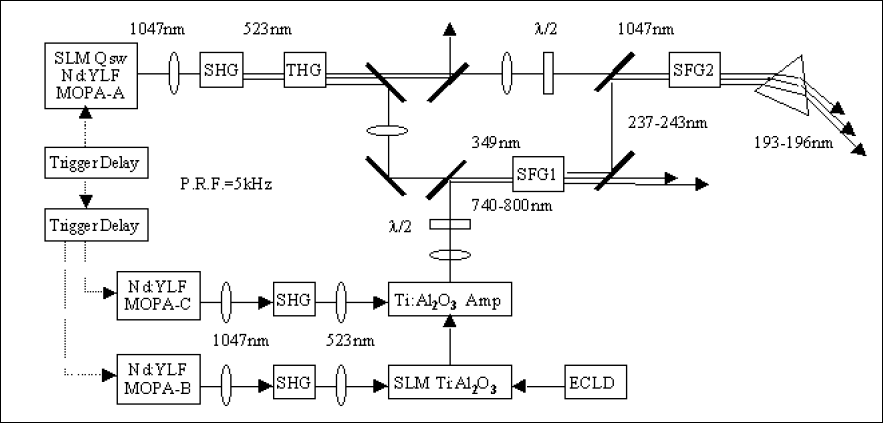
Figure 4. Schematic of sum-frequency generation setup.
3.2 THIRD HARMONIC GENERATION
As the first step to DUV, the IR output from MOPA-A was simply focused by a positive spherical lens to produce green in a SHG crystal. We used an 18-mm long, AR-coated, temperature-tuned NCPM LBO. The maximum power at 523.5nm measured was 23W at an incident power of 38W, representing the optical conversion efficiency of 60.5%. By utilizing a 15-mm long, AR-coated, angle-tuned, temperature-stabilized Type-II LBO crystal for the subsequent process, the green and residual 1047nm beams were mixed to generate the THG output at 349nm. Any optics was not placed between two LBO crystals. We obtained the maximum THG output power of 16.2W corresponding to a conversion efficiency of 42.6% from IR to UV. To our knowledge, it is the highest power as a TEM00 output of THG generated from an all-solid-state laser. It should be pointed out that the maximum average power at 349nm was obtained by reducing the SHG power to ~16W, corresponding a 40% of the SHG conversion efficiency. In general, the optimum SHG efficiency is 67% giving an equal numbers of the fundamental and second harmonic photons incident on THG crystal. This discrepancy was investigated by a numerical method based on the coupled-wave equations governing a three-wave interaction expressed as follows.
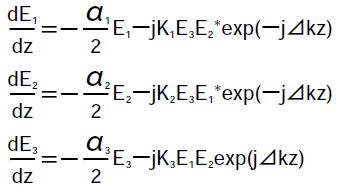
In the calculation, we assumed that both temporal and spatial distribution of the initial fundamental were gaussian. We neglected any dephasing effect, walk-off and diffraction. Figure 5 illustrates the dependence of the THG conversion efficiency on the SHG efficiency as a parameter of peak intensity of initial fundamental, obtained by integrating the calculated distributions with respect to both time and spatial coordinates. The results agree well with the experimental results in terms of the optimum SHG efficiency.
3.3 TI:SAPPHIRE LASER
As the tunable source, a single frequency Ti:sapphire laser MOPA system have been developed. The master oscillator consists of an astigmatically compensated, bowtie ring cavity, a Brewster-cut Ti:sapphire crystal, and a birefringent filter. One of the cavity mirrors is mounted to a PZT to tune the cavity length in resonance with the seed laser. The system pumped by 9.2W of 523.5nm and also seeded by an external cavity diode laser, produced over 3W of single frequency, TEM00 output at 785nm with a 5-kHz pulse-repetition rate. The SHG output of MOPA-C was split into two beams via a beamsplitter and introduced into both ends of a Ti:sapphire crystal for pumping. The incident powers were 5.8W and 5.5W respectively. A pulse delay generator was used to control the timing of Q-switching trigger of MOPA-B and MOPA-C to match the arrival of incident pulses to the maximum gain created in the amplifier. The NIR output from the oscillator was amplified up to 7W in a single-pass configuration.
3.4 FIRST SUM-FREQUENCY GENERATION
The primary technical challenge in the development is the need to obtain efficient SFM of two beams generated from separated laser systems at high-repetition rates. In general, SFM utilizing the second-order nonlinear optical process is an established method that has been widely applied to up-conversion of visible or infrared radiation into UV and DUV regions. However, most of the previous works utilized dye lasers or Nd:YAG lasers operated at lowrepetition rates, thus the phase-matching limitations such as angular acceptance or walk-off were not the critical issues. Otherwise, the two mixing beams were originated from one laser system, whereby their temporal overlap was automatically fulfilled. In our case, two beams being generated from separated lasers should be created or shaped so as to match both temporal and spatial distributions with respect to each other. Additionally the optimization of the conventional parameters such as crystal length and peak intensities must be considered. As the nonlinear optical to generate the UV at 241.6nm, BBO or CLBO could be employed. Table 3 shows their calculated properties. We chose CLBO from the viewpoint of allowing wide acceptance angle.
In the experiment, we characterized the two beams very carefully and thereby designed the shaping optics to realize well-collimated, astigmatically-compensated beams that should be also same in size at the CLBO crystal. Two beams were combined via a harmonic combining mirror and coupled into the CLBO crystal. The crystal was grown by USHIO under the direction of Osaka University. It was cut at 64o for type-I phasematching, 7x8x20mm in size and mounted in an oven kept at 150°>C to eliminate hydration. The beam diameters giving the best performance were 1.0x0.6mm for the Ti:sapphire and 1.2x0.7mm for THG. The temporal overlap of each beam was realized by a digital delay generator controlling the Q-switching trigger of MOPA-A and MOPA-B. The maximum UV power at 241.6nm was 3.4W with the input of 9W at 349nm and 6W at 785nm, representing the overall efficiency of 23%. Although the THG power incident onto the crystal was limited to only 55% of its full power due to damages to the combining mirror, the obtained power is to our knowledge the highest power generated by SFM of two beams from separated laser systems. We observed an evident thermal effect in the CLBO crystal generating W-level of UV at 241.6nm, which resulted in the need to adjust the phasematching angle of the crystal to maintain the UV power.

Table 3. Calculated properties of CLBO and BBO crystal for the 241nm generation.
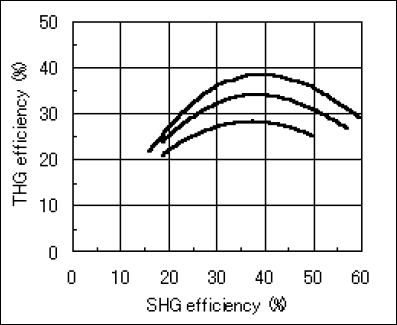
Figure 5. Calculated dependence of THG conversion efficiency on SHG efficiency as a parameter of peak intensity of initial fundamental.
3.5 DUV GENERATION
The first SFM beam and the residual IR beam exiting from the THG crystal were made collinear by means of a coated mirror having 91.5% of reflectivity at 241.6nm and 85% of transmittance at 1047nm. The IR beam was characterized and then shaped with the optics designed to form a collimated beam with 1.0-mm spot size, while the first SFM beam was not shaped. As the mixing crystal, a 10-mm long CLBO cut at 90° was employed. The crystal was kept at a temperature of 340C to realize the NCPM condition as was described in [2]. Figure 6 shows the DUV power obtained as a function of input UV power while maintaining the input power of IR at 7.8W. The 196-nm power was calibrated by taking 75% of transmittance of the prism used for beam separation into account. The maximum power produced was 1.53W with a conversion efficiency of 14.3%. We also evaluated the linewidth of DUV using an air-spaced etalon with 7.5-GHz FSR and finesse of 40 specified at 193.4nm. Figure 7 shows a fringe pattern created by the DUV radiation. Although the finesse of etalon at 196.3nm was unknown, the pattern clearly indicated the line-narrowed output that was evaluated to be no greater than 400MHz. Figure 8 shows the temporal pulse shape, each of which exhibits a smooth profile with no beating, associated with the SLM operation of both lasers. A pulse shortening effect by the nonlinear conversion process can be seen. We also generated the 193.4-nm light by operating the Ti:sapphire laser at 741nm and applying a BBO crystal to the second SFM for a measurement purpose. The linewidth of 193.4nm was measured to be less than 180MHz(0.023pm) that should be the resolution limit of the device.
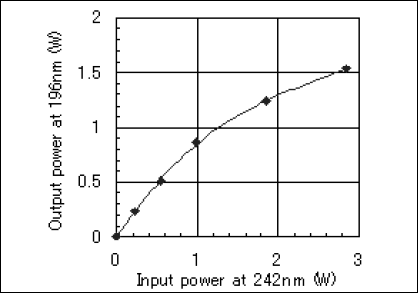
Figure 6. I/O date for DUV generation.
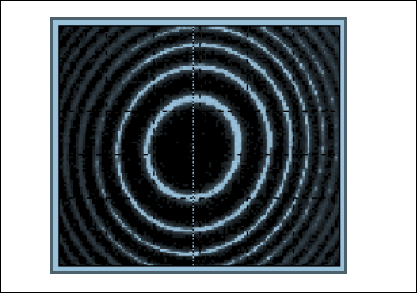
Fringe pattern created by DUV radiation.

Figure 8. Measured pulse shapes of Ti:sapphire, THG, first SFM, and second SFM (10ns/div).
4. SUMMARY
In summary, we have developed an all-solid-state, narrowband DUV laser system based on SFM of two singlefrequency laser outputs using CLBO crystals. The source generated 1.5W of 196.3nm at a 5kHz with measured bandwidth of less than 400MHz. While the effort emphasized the generation of DUV below 200nm, the system also produced the spectrally-narrowed output at 241.6nm with over 3W of average power. Since this source is tunable, it could be useful for various applications such as micro-machining, photolithography, inspection, and writing of gratings into fibers.

